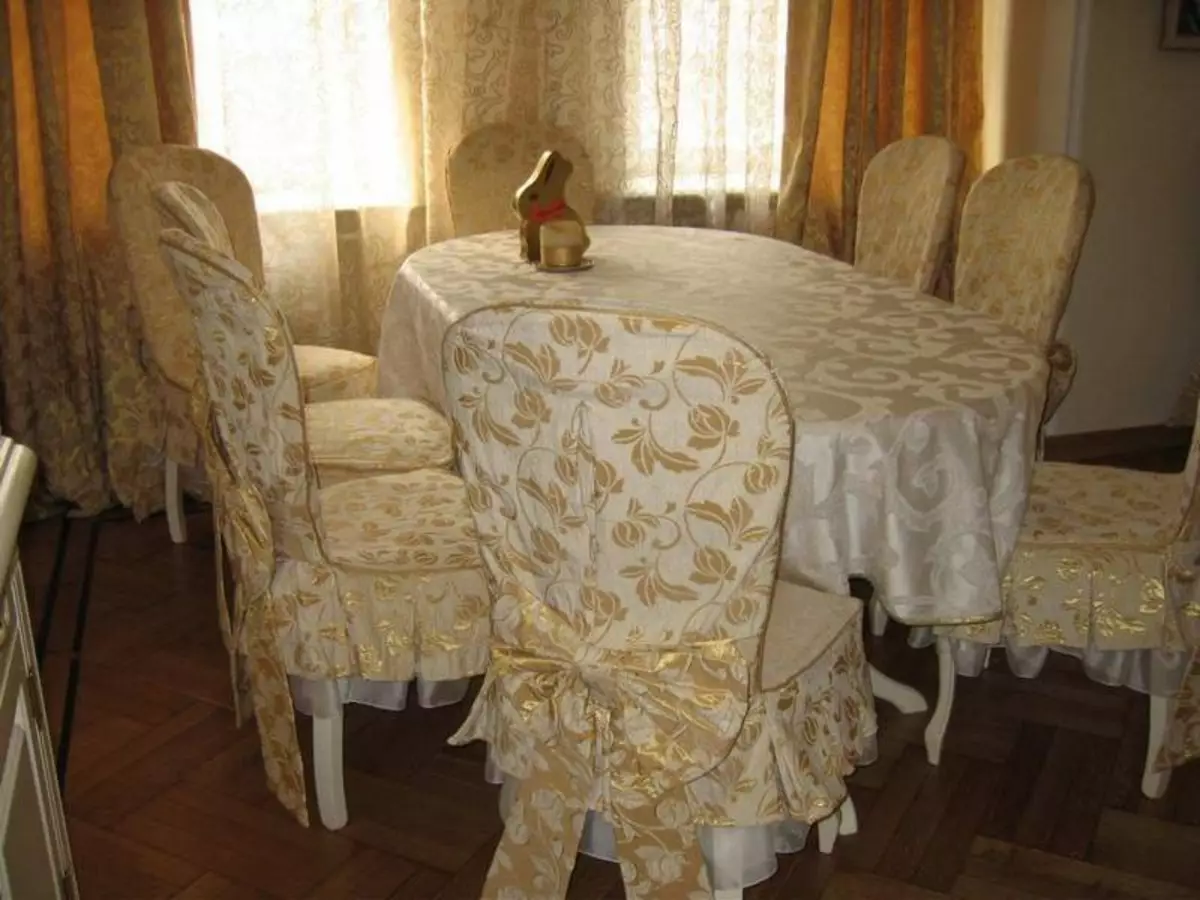
The kitchen is a space that is subjected daily by high operational loads. Therefore, it is necessary to make incredible efforts to support cleanliness, as well as maintain a presentable type of finish and interior items. There are enough simple techniques that allow realizing similar aspirations. Here, for example, covers for chairs in the kitchen fulfill a special role. Their function is clearly visible and is quite well determined. Their application has a number of indisputable advantages, so it makes sense to tell about what types of covers for chairs into the kitchen with their own hands make the easiest way to make cutting such products.
Basic functions of covers
Like any other thing, the covers for kitchen chairs have its purpose. Their functions are obvious:
- Protective.
- Functional.
- Aesthetic.
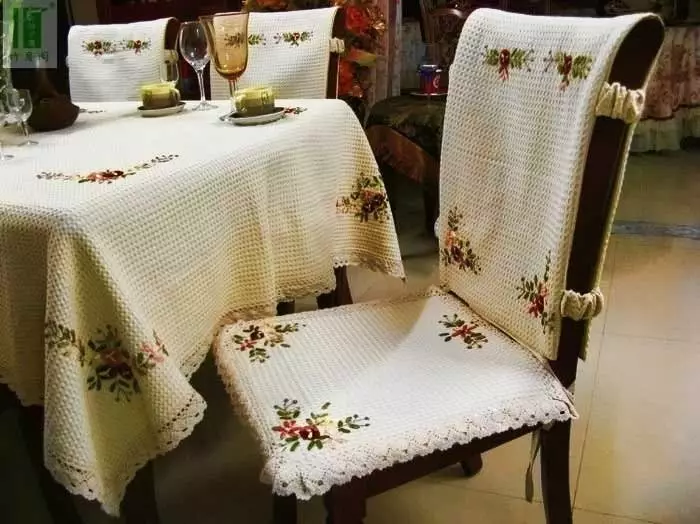
Much depends on what situation the items described are used. There are those products that are used daily, others - only on solemn days, third for seasons (in summer or in winter, autumn or spring). Until recently, the covers on the chairs were considered a remnant of the past, today a lot has changed, they are experiencing their second birth and again in trend.
Putting on chairs, many trying to protect dear furniture from dirt, or vice versa, cover them unsightly from aesthetic point of view. A simple cape sometimes just saves the situation, and allows the owners to blush less in front of the guests for the slope of the furniture.
Summarizing all of the above is easy to formulate the main advantages of applying covers for kitchen chairs.
- Any case, if necessary, can be easily removed and wrapped in a typewriter.
- The described product allows you to move the purchase of new furniture for an indefinite period. No need to spend money and tightening the chair.
- You can easily change the capes, and with them to change the mood of the interior.
- Removable chairs on chairs protect furniture from pets. Especially cats love to scratch their claws about the upholstery, and if it is made of leather or its substitute, the described interior items are faster.
Listing such factors, it becomes clear why capes for kitchen chairs are experiencing their second birth. In order for them to cope with their main functions, it is important for their sewing to choose the right material. Therefore, it makes sense to talk about it in more detail.
What materials are best used in the kitchen
What is the best to sew covers? The answer to this question must be sought in the features of the use of the described room. Sometimes the kitchen space is not used for its intended purpose. Over the kitchen table is often made lessons, crafts are going, any other useful things are going. That is why it is important to choose a material with high dirt-repellent properties to protect chairs. Its surface should allow the founding of the "breathe" stool, while the structure of the tissue should be durable, resistant to frequent washers or dry cleaning.
Article on the topic: Cardboard boxes: Toys for children and ideas for home (39 photos)
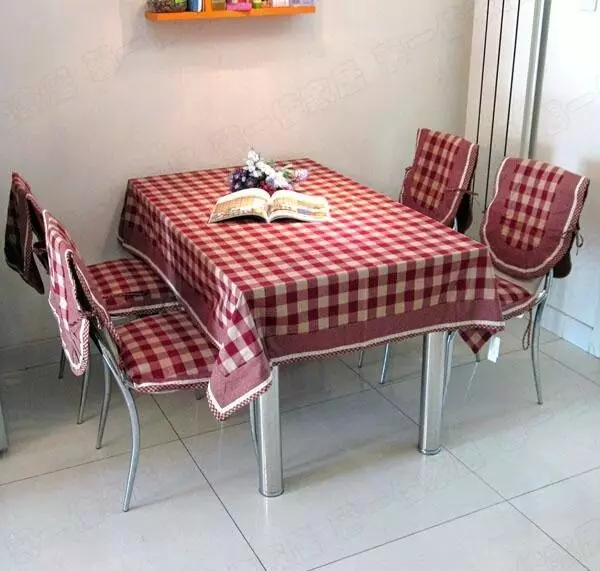
Similar properties have different fabrics. The most popular for sewing covers is gabardine, crest-satin, husky and organza.
What is gabardine? This is a fabric, with a very dense structure, while the material to the touch is very thin. It always lies with the volumetric items, softly enveloping them. The fabric is based on natural threads (cotton or silk), it is they who give the front side of the noble glitter. Gabardine is perfect for the manufacture of parade covers.
What is a crete satin? This is also a fairly soft and elastic material, with a solid structure. It demonstrates high resistance to pollution, the front side practically does not form rubbing. If you look at the products, sewn from crepe-satin, from afar, you might think that they are made of atlas. Sooter crea is ideal for tailoring products, which suggests folds or assemblies. Very spectacularly watching Casters from Satin for tool.
What is Lycra? This material that, if necessary, is very well stretched and takes the form of the subject. Liker is quite easy to clean, it can be washed in a typewriter, after washing the material dries quickly. Similar selection designers advise to do if you want to create bright interiors. Lycra always has a smooth surface with a beautiful glitter glitter.
What is an organza? This fabric, as part of which there are three components: silk, polyester and viscose. It has a dense structure, the material is completely transparent, but if necessary, it is well holding a form. Organza is obtained rather decorative than practical covers. Designers recommend them to use them for decorating a kitchen-studio.
Features Croy
There are several varieties of cut shapes for chairs. For the kitchen are suitable three:- As permanent, daily products used are best suited tightly sitting covers. They are most closely adjacent to the back of the chair and to its seat, so tight that it is quite difficult to remove the cape. Such a cut is well protected by soft parts of the furniture item, cover the small parts of the frame, starting with the back, ending with the legs.
- Free clock allows you to quickly transform furniture as quickly as possible. As a rule, a similar sewing option is used to create parade festive capes, therefore, expensive fabrics are applied to their manufacture.
- Caid drapery covers are designed to cover unsightly parts of the chair or add comfort during their application. So, for example, if the chair is spoiled by the seat upholstery, it can be closed with a cape with a lower draper. If you add to the upper part of the foam rubber, it will be softer on the stool.
Selection of style covers
Above the features of the choice of the described product, taking into account the shape of the cut, and the material for its manufacture. It remains to tell how important it is to be able to pick up a style, taking into account the style of design of the kitchen.
Article on the topic: glue wallpaper on paint: general work technique
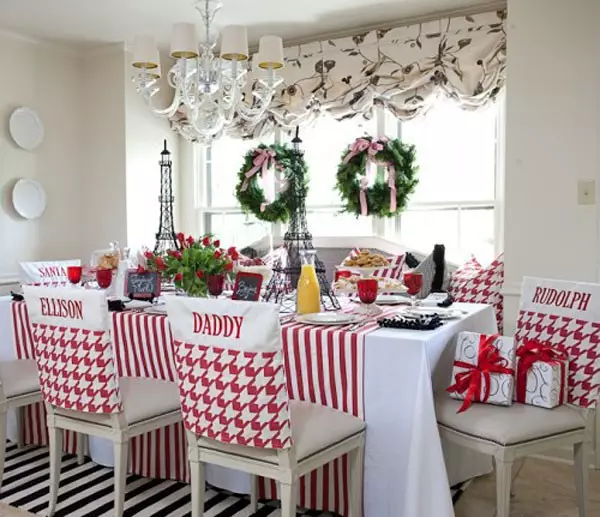
- For the style of Country, for example, or for Provence, cotton covers stitched from a colorful fabric with a soft pastel palette. Cape In this case, it is better to sew straight, simple shape without drapery.
- For the style of Bocho, experts recommend choosing capes for chairs, stitched from coarse burlap. Such a fabric looks perfectly against the background of natural wood, actively used to recreate eco directions.
- The one who loves the classics can choose any in the form of covers, those of them that are sewn from noble tissues (organza, brocade, crepe-satin). Such capes once again emphasize the atmosphere of aristocracy.
- Modern styles (High-tech, minimalism) also allow the application of the described decor elements. The main thing here is to minimize the use of any jewelry. Covers should be sewn simply, concise, of simple monophonic fabrics. You can use a material with a metal tump.
Note! Cape for chairs in the kitchen for everyday use and for a solemn incident must differ from each other. For the first case, experts recommend applying straight cut, but Ryushi, drapery, bows, strings, satin ribbons to leave for sewing festive cape. In any case, the color of the material must be mistaken with the color of the tablecloth or textile window design. Beautifully look at the products stitched from tissues of calm colors. They will not be perceived boring if bright details add to the table serving, in the arrangement of additional accessories (napkins, dishes).
Tips for those who want to try to sew covers do it yourself
An experienced master knows how much fabric may be needed for sewing one cover for one chair in the kitchen, how to cut the described product, how to sew it. Newbie, facing such problems, is in a hurry to carefully examine the advice of professionals. They help to avoid the emergence of the most popular errors.
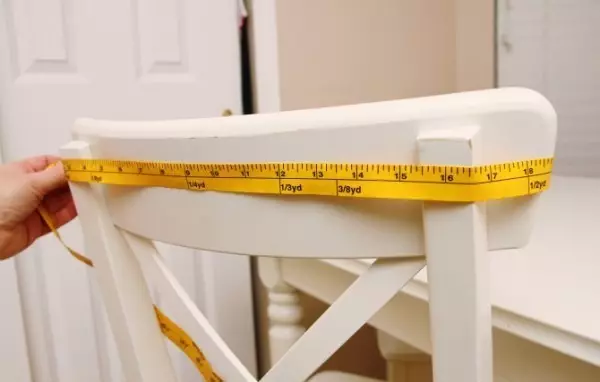
So, for one case, you must purchase a half or two meters, depending on the selected model. For daily use, you do not need to purchase expensive fabric, the main thing is that the material is durable.
Making pattern
In order to make the pattern of the cover, you must first decide on the cape form, with its style, and only then remove the dimensions from the paper from the chair. The task is simplified in the presence of the skills of the seamstress, with their absence it is necessary to armared with scissors, loose paper and scotch. Using them, the union of the future pattern is made as follows: the paper is wrapped with the details of the chair (the front back, the seat, the paper around the legs form the lower skirt of the future cover). The paper is attached to the stool of Scotch. Then scissors cut a paper case.The described method of cutting helps quite easily create accurate patterns, you can already cover the details of the future cape from the fabric. It is important to properly decompose the pattern and make an allowance on the tissue on the seams and on the bending of the material. If it is possible to decompose the molding on the tissue in such a way that there are as few spaces between adjacent parts, the tissue consumption will be economical.
Note! The location of the details of the pattern is carried out in the direction of the equity thread.
Preliminary work
Of course, many will tell you that it is not necessary to suffer and make a pattern. You can always seek help to the Internet and there is already ready to be ready. But, as practice shows, it is difficult to find standard universal solutions in our time. Each chair has its own configuration, so it is easy to make mistakes in this matter.
Article on the topic: How can I make a folding sofa with your own hands
Without a doubt, to simplify the task may be ready-made patterns, if they take them as a basis and already on them with the help of a carting to paint their own patterns. Experts recommend to act all novice needlewomen in the following direction:
- With the help of tracing and finished pattern, try to make exactly the fitted pattern of one particular chair.
- Buy an inexpensive tissue, it is trained on it and in stripping, and in the sewing of the selected model. Always at hand there are old sheets, curtain, unnecessary bedspread. Let it become an experimental sample.
- In front of the line it is useful to manually make fit, try stitched parts directly on the stool. It is necessary to scribble only when the case snaps into a stool as cast.
After that, if the experience and its results will like, you can go to the store and acquire a closed cloth for sewing the final version.
How to connect the items?
Sewing covers for chairs has its own characteristics. The fact is that only part of the color details are stitched together. The rest are not stitched, but remain uneasy. Such a tailoring allows you to then wear the product on the described interior object.All edges of the unimpressed elements must be treated with overlock. If there is no one at hand, then you can simply make a zigzag line at the edges. It will help protect the edges of the fabric from sprinkling. It is easy to find dense fabrics, the edges that do not need to be processed when sewing. It will work easier with them and faster.
The straight covers are tightly on the chair, if there is a lightning in the side seams.
When sewing simple capeties, it is important to think over the ways of their fastening to the subject of the interior. The mount should be such a cape then not going to the seat on the seat.
If separate seats capes are sewn or for the back of the chair, the perimeter is better to separate the gum, or skip the braid. Such elements provide the most reliable fastening of the cover. The presence of gum involves the need to add several centimeters to the podgib.
Generalization on the topic
The kitchen is the place where something is constantly dirty. Tissue covers protect furniture from characteristic contaminants. They perform not only a practical function, with such elements of the decor it is easy to change the mood of a small space. The article contains all the necessary information about the product described.
